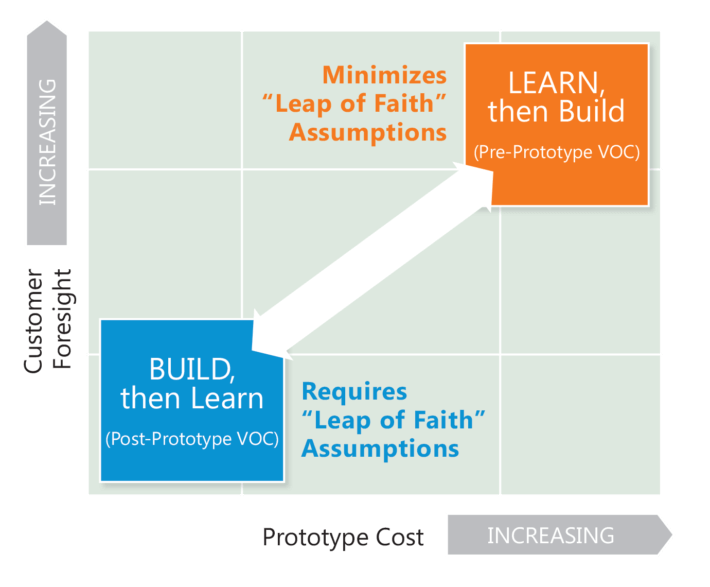Lean Startup for B2B: A Great Approach if… We Make This Key Adjustment

Lean Startup is a fast, nimble approach to creating new products, which was born in Silicon Valley… and is gaining traction in the corporate world. You can learn more by reading the HBR article, “Why the Lean Startup Changes Everything,” by Steve Blank, and the book, The Lean Startup, by Eric Reis. ut what about lean startup for B2B? Well, first let’s explore lean startup itself. Some key tenets are…
- Don’t create an elaborate business plan, which limits your flexibility and openness to learning.
- Instead, create a “business model canvas” which lays out your assumptions to be tested.
- Use “minimum viable products” to rapidly test product hypotheses with customers.
- Employ agile product development cycles with many nimble “pivot or persevere” decision points.
Lean Startup is based on a Build-Measure-Learn process. Imagine you are developing a new consumer phone app: You would create a quick prototype, or “minimum viable product” (Build), test this with consumers (Measure), and use their feedback to make needed changes to your design (Learn). You would “rinse and repeat”… with learning cycles that rapidly move you closer to a winning design.
Adjusting Lean Startup for B2B
We love it when our clients explore Lean Startup, because we see in it a “kindred spirit” to New Product Blueprinting: Learn from your prospective customers before you commit to what you’ll offer them. @aim_institute. This keep-your-mind-open-and-wallet-shut approach boosts new product success and shortens timelines.
At the same time, we recommend an “adjustment” to lean startup for B2B suppliers: Instead of applying a Build-Measure-Learn cycle, employ a Learn-Build-Measure-Learn cycle:

When you begin with “Build,” you are starting with a hypothesis of what customers want, which often makes sense for consumer products. Imagine you’re developing a new computer game. Until consumers actually experience your product (or its prototype), how could they predict whether they will be entertained? So if you are developing a B2C product that is designed to increase a consumer’s amusement, comfort, taste sensation or sense of self-worth, you may be ok with the pure Lean Startup approach.
But imagine you are developing a new welding machine for auto assembly. Let’s think about how we’d apply lean startup for B2B. Your customers could foresee their needs before they experience your product. You could learn that customers wanted faster welding rates, less spatter, reduced metal pre-cleaning, and lower energy consumption… before they ever saw a physical prototype or minimum viable product.
So for knowledgeable B2B customers driven by hard economics, you should begin with “Learn” before “Build.” You can do this nicely with New Product Blueprinting’s B2B-optimized voice-of-customer (VOC) interviews and observation.
Managing “Leap of Faith” Assumptions
Lean Startup methodology refers to “Leap of Faith Assumptions”… a term that nicely highlights the shaky foundation of most suppliers’ hypotheses. Lean Startup wisely recommends testing assumptions and learning from customers at the first opportunity.
Let’s consider a lean startup for B2B concept. For most B2B suppliers, this “first opportunity” to learn comes before a prototype is created… through early voice-of-customer interviews that mine the insight and foresight of highly-knowledgeable customers. Why take a leap of faith when you could take a leap of confidence-even more quickly and cheaply?
Why take a leap of faith when you could take a leap of confidence-even more quickly and cheaply? @aim_institute
When considering whether you should start with a) your hypothesis and a prototype (Build), or b) voice-of-customer interviews (Learn), also consider the time and financial cost to create a prototype. In all cases, you need to conduct VOC research with potential customers. If the cost of a prototype is high and customers have a great deal of foresight, you should conduct some of this VOC before creating your first prototype or “minimally viable product.”

Lean Startup for B2B: Blueprinting and Lean Startup Together
Over the years, many B2B suppliers have fallen into the trap of developing their own solutions-or at least hypotheses-only to be crestfallen when customers were far less enthusiastic than they. Lean Startup minimizes this problem by showing potential customers an early, inexpensive minimum viable product. This is a very good thing.
But don’t stop there. You can further minimize and even eliminate such unpleasant surprises with B2B-optimized VOC, before you even create your MVP. This increases your speed and reduces your waste. But wait… there’s more. The type of VOC we’re suggesting gives you two more advantages:
- Done with skill, the customer—not the supplier—suggests the topics covered in these VOC sessions. Customers will often lead you to outcomes (desired end results) that you would never have imagined in your conference rooms.
- With such interviews, you engage prospective customers early in the process. When they help you design your product in collaborative VOC sessions, they’re much more likely to be “primed” to purchase your product later.
So our recommendation is to begin with Blueprinting Discovery (qualitative, divergent) VOC interviews, followed by Blueprinting Preference (quantitative, convergent) interviews. When finished, you will have a crystal-clear picture of what customers want. Now move briskly into your Lean Startup for B2B mode… rapidly showing customers minimum viable products. Since your MVPs are focused on their outcomes, you’ll have confidence they will be interested and you’ll be on the right track.
Learning More…
Several of our clients are implementing the principles of Lean Startup in combination with New Product Blueprinting methodology. If you’d like to “learn what we’ve been learning,” download the “Lean Startup for B2B: Adding a Key Step for B2B Innovation” White Paper. To learn even more, please contact us or reach out for a free private consultation on New Product Blueprinting .
Comments